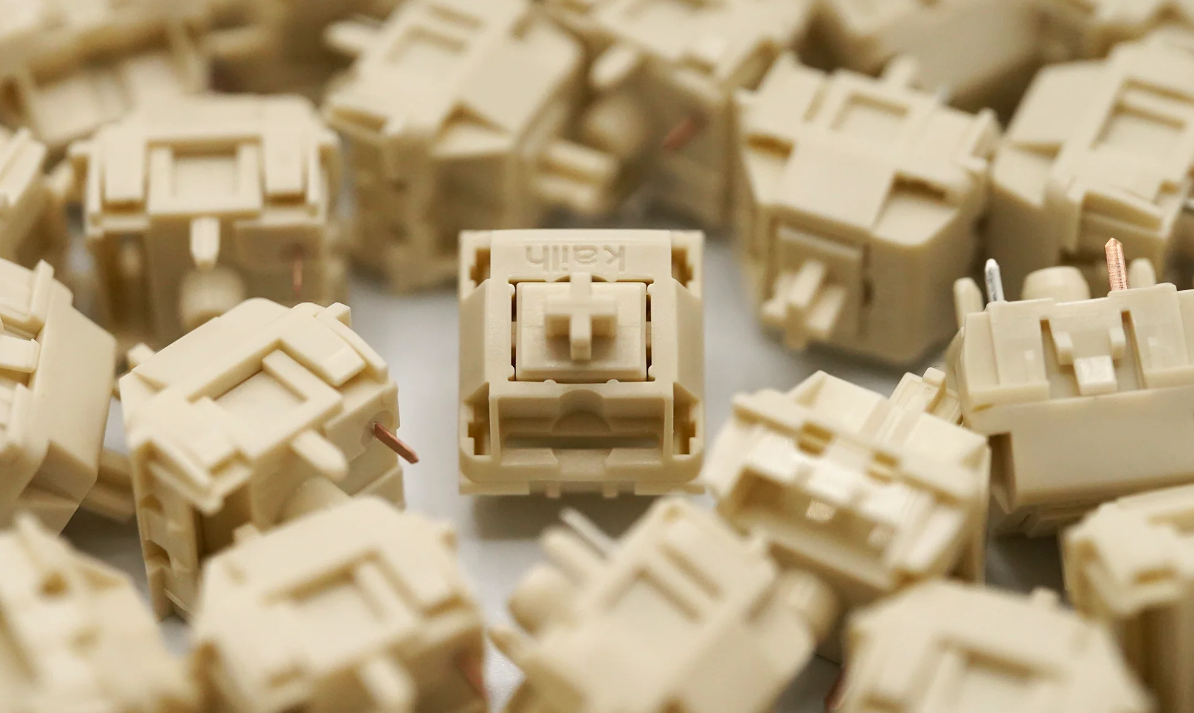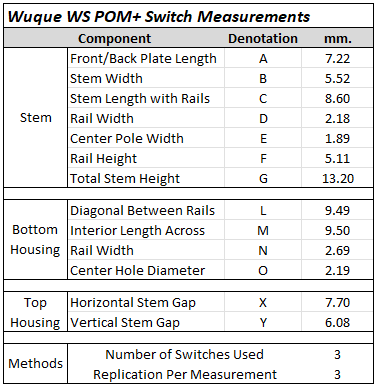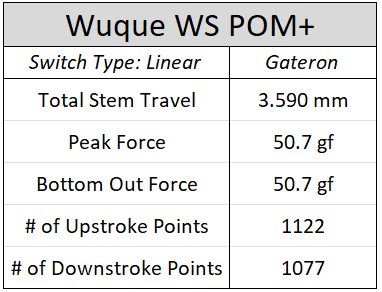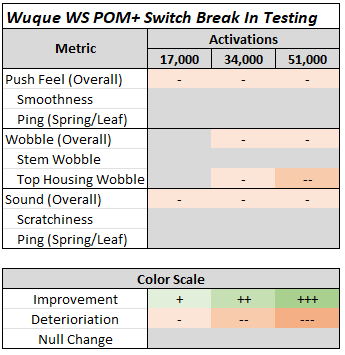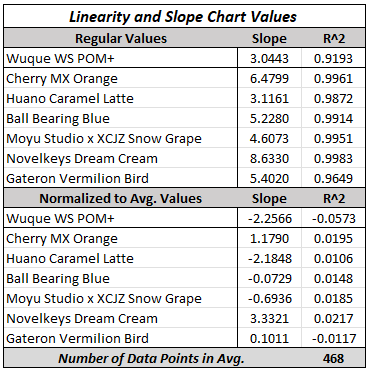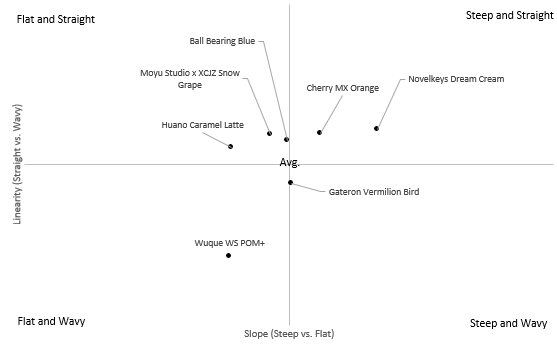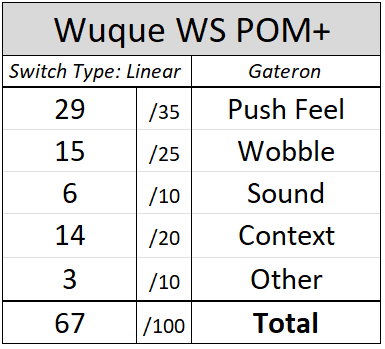Wuque WS POM+ Switch Review
Alright, alright – I’ll finally do something about ‘it’. After months of complaints, comments, and critiques about the reviews, I’ve come around to my sensibilities and fully intend to announce a change in content next weekend that will fix everything. Please don’t be fooled into thinking that this is actually something that I was thinking about sincerely over a long period of time and have been slow to act given the complexity of the situation – this is an immediate, knee-jerk reaction that is meant to capture nothing but approval and adoration from you all. Wait, what was that? Did you actually think there for a second that I was going to shorten these full length reviews? Fuck that, they will be staying as long as ever and I will likely increase them even more in time when I find more data or information to cram into them. Instead of forsaking my trademark tangentiality, I’m opening up this article by briefly announcing that there will be a modification to my switch ranking system next weekend that will become permanent moving forward.
Figure 1: An average Friday night of me writing switch reviews.
While that introductory paragraph felt a bit self-serving and particularly short on any substantive details about how I will be changing the scoring/ranking system, I’m doing so in order to slightly soften the seemingly out-of-left-field nature that that announcement will come as to many readers. Even though the changes that I have finally fully worked out in my mind are by no means super radical in their effects, there’s enough nuance in that decision making around adjusting how switches are ranked that it will require an accompanying short article to really hammer out those details. Either that, or I don’t know how to adequately summarize any of my thoughts. In the grand scheme of things, I think that these changes will ultimately better my switch scoring system and make it a little more rugged despite the facts that it has worked pretty damn well over the past few years and that it is entirely subjective. (That’s right – if you think my word(s) about switches is the ultimate, objective truth, you’re wrong and I will gladly tell you that you are wrong.) So in order to not be blindsided by this change in the scoring and ranking of switches in the review two weeks from now, consider checking out my short article about this change that I’ve planned to release roughly a week from now. In the meantime, enjoy the last review before this small, but pretty powerful change takes effect – it’ll be the first change to the system in many years.
Switch Background
Imagine for a second that you had to pick a plastic that is representative of all modern mechanical keyboard switches. The most immediate short list that would be generated from polling people includes polycarbonate and nylon, as these have comprised the majority of top and bottom housings of switches since the start of the modern scene back in 2016. If you ask me, though, I’d make a strong claim that that list should actually have a third thermoplastic on it – POM. Despite few people in the broader community at large recognizing its ubiquity, POM has been the default stem material in all modern MX-style switches since the MX footprint was first invented, only very recently having started to be supplanted by new, strange takes on switch plastics in the custom keyboard community. What the broader community recognizes POM for instead is the few but surprisingly not far in between switches which are constructed solely of this material, decking out both housings in POM in addition to their stems. First introduced as a concept back in 2018 with the development and announcement of Novelkeys’ Cream switches, people have since formed a whole lot of very opinionated takes on what POM is and how POM switches perform. (Note that these opinions are not all that uncommonly contradictory or downright antagonistic against other people’s takes.) And so while we as a community are all familiar with the use cases of POM, very few of us are even aware of what POM is and why it makes switches that can be marketed around its inclusion, such as the Wuque WS POM+ switches.
Figure 2: It's hard to think POM switches, as a concept, are over 6 years old at this point...
‘POM’ is the shorthand name for the thermoplastic more formally known as ‘Polyoxymethylene’. Sometimes referred to by other names such as ‘Acetal’, ‘Polyacetal’, or ‘Polyformaldehyde’, this material is an engineering thermoplastic that commonly finds itself used in the creation of parts that simultaneously require a strong, stiff construction with a smooth, very low friction surface finish. While this certainly sounds like an obvious description for components like MX-style switch stems, POM can take quite a bit more of a beating than what keyboards can deliver, with it being used in things like mechanical gearing and pumps, components for cars and railways, and even some other recreationally abused products like pens and guitar picks. Part of what has ensured the widespread use of POM across several different industries is the fact it is over 70 years old in and of itself, with commercialization efforts from massive corporations like DuPont and BASF starting back in the 1960’s. However, that is not entirely what has made POM as popular as it is. POM is an incredibly versatile thermoplastic from a manufacturing perspective, and because of the large rainbow of use cases that exist for it out there, there’s quite a few different ways that “POM” is actually made and molded into the parts that it gets used in. To think that all of these parts, switch stems and housings included, would be made out of pure POM is just wrong.
Figure 3: Molecular structure of POM, for the rare few of you in the hobby into chemistry.
While people with background experience in manufacturing plastic composites almost certainly know where I’m headed with this train of thought, very few people in the keyboard community seem to have first hand experience with plastics manufacturing and thus don’t seem to recognize that not all POM, or nylon and polycarbonate for that matter, is made equally. (Thankfully I’ve been working in a plastics composites facility for a few years now so you can trust me on this one.) In almost all industrial settings, companies will add chemicals, solvents, resins, powders, etc. to their materials in order to make them both processable in the facility as well as to best meet the demands of the final goods they are being used in. More specifically, things like rheology modifiers and plasticizers may be added to POM in the manufacturing process to make them more soft and flexible for injection molding processes. Or, they may add materials like UV light stabilizers, toughening agents, or even dyes and colorants to make a finalized POM part that meets their customer’s requirements. For the sake of sanity, you can just assume that every company that uses POM in their parts will have different recipes that they use to get there – kind of like how every grandmother seems to have a different secret spaghetti sauce recipe. Much like with how your grandma may use sugar or another would use powdered sage in their sauce, these differences in additives make an impact on the final POM products and at least the people in the keyboard community specifically seem to be able to tell the difference. (Factory lubing aside, just consider the differences between the POM feeling in Kailh-made Novelkeys Cream switches and Durock/JWK-made Durock POMs…) What if were to tell you, though, that the differences between the recipes of POM went even deeper than just the herbs and spices though? What if the POM itself is available to manufacturers in more than one type?
Figure 4: I demand at least one free pack of switches when one of you inevitably decides to release a full POM 'Spaghetti' switch.
Back in the early 1950’s when POM was first discovered by Herman Staudinger, and synthesized in parallel by chemists at DuPont, there were some issues with how the final polymer material performed. In particular, the ‘homopolymer’ version of POM, which used only polymerized formaldehyde units, was not particularly thermostable and would break down at any commercially or manufacturing relevant temperatures. It wasn’t until a bit later in the 1950’s that Stephen Dal Nogare developed a much more stable homopolymer version by capping off the ends of the plastic chains with acetic anhydride, leading to a rapid commercialization of this version of POM under the trade name of Delrin – which is still purchasable today from DuPont. Wanting a piece of the pie that DuPont was hoarding for themselves, several other companies began cropping up in the POM manufacturing space, one of which named Celanese discovered that a copolymer of POM could be formed, in which 1-2% of the formaldehyde groups could be swapped out for ethylene oxide instead. While this sounds like only a minor technical point that Celanese would use to market themselves apart from DuPont, this copolymer form of POM was found to have generally better characteristics than the homopolymer form, including better UV stability, thermostability, and toughness as well. Today, both copolymer and homopolymer versions of POM are still available for purchase and commercially viable – with the copolymer version being purchasable from BASF as Ultraform and Celanese as Celcon, and the homopolymer being available still as Delrin. As to where the switch manufacturers are purchasing their POM resins from, though, we really don’t have the slightest clue. So while we may be able to tell one POM recipe used at one manufacturer apart from another like differently seasoned spaghetti sauces, the reality is that each recipe could be using entirely different types of tomatoes as their base – and I’ll be the first to tell you that I can’t tell them apart by taste…
Without actually having first hand knowledge, I feel safe in speculating that the original decision by Mike of Novelkeys to push for switches that had POM housings in addition to POM stems very likely could have been made out innovative convenience rather than specific design intent. After all, POM was clearly useful in keyboard switches already and had seen consistent success as a stem material in Kailh switches for multiple years on end. Why wouldn’t he also then think it likely would make for good housings as well? Upon trying the prototypes out, though, I’m sure the team at Novelkeys was convinced that this was truly a groundbreaking design choice. However, I do want to point out that the big marketing point that was floating around about Novelkeys Cream switches back in 2018 was not their rigidity or general smoothness – features known to be true for both homopolymer and copolymer POM – but rather it was their “self lubricating” nature. To put it simply – POM thermoplastic material, on its own, does not self lubricate to the best of my knowledge. POM can be made to be self lubricating, though, via the use of processing modifiers. At least in my head, this means that the original Novelkeys Cream switches were not self lubricating because they were made of POM, but rather because they were made with Kailh’s specific recipe of POM. The specific recipe passed down by Kailh’s grandmother, if you will. As time has gone on and POM switches have become available by more manufacturers and in increasing number, its interesting to see that this expectation and marketing point has not disappeared, however. Resulting from the demands and expectations that the community is putting on switch manufacturers, its quite likely that they are seeking out modified POM resins to meet these specifications in the end products – and as each one gets a new formula to try and meet the smooth, sturdy, and self lubricating demands, we are getting different types of POM from each company. So while it perhaps isn’t wrong to think that all POM switches are trying to be the same – potentially chasing the marketing dragon first unleashed by Novelkeys Cream switches – its almost certain that all of them are just quite a bit different from one another.
As for one of Gateron’s latest attempts at producing full POM switches, the Wuque WS POM+ switches were first listed for sale by Wuque Studio on May 11th of 2024. Price at $16.50 per pack of 35 switches, or $0.47 per switch, these were soon rapidly available through nearly a dozen different proxy vendors around the world as is common for Wuque’s switch releases. As of the writing of this review, all vendors that initially proxied the sale of the WS POM+ switches still continue to stock them as of 5 months later. Unlike many WS-branded releases before them, these monocolored light purple linears were made by and exclusively branded with Gateron nameplates, coming with a 55-gram bottom out weight and an elongated, multi-stage 22 mm. long spring. While Wuque Studio has historically been very generous with the distribution of their switches around the globe and consistent in their restocking and long term support, the less distinctive marking of these switches as being part of Wuque Studio, in addition to the other handfuls of switches before them which are still being supported to this day, the long term support and availability of the WS POM+ switches by Wuque Studio is unknown.
WS POM+ Performance
Appearance
At the highest level, the Wuque WS POM+ switches come in a fully opaque, lilac purple colored housing construction that is certainly striking though not entirely standout relative to the rest of the field of switches available today. Further making it difficult to distinguish these switches is their lack of ‘Wuque’ branding anywhere on the switch, despite what the name suggests. Unlike a good number of Wuque Studio/WS named switches released before them, the POM+ switches have an inverted Gateron nameplate, making them only the second WS switch to feature such alongside the Dash HE Magnetic switches. Beyond the unique combination of color and nameplate, all other details worth noting about the WS POM+ switches occurs at the sub-part level and may be found in the paragraphs and photos below.
Figure 5: Wuque WS POM+ switches and their components.
Looking first to the lilac purple, POM top housings of the Wuque WS POM+ switches, these switches clearly feature the ‘updated’ mold designs that Gateron has been transitioning into for some time now but lack unique characteristics which would imply a specific set of molds being used strictly for these switches. The feature that most certainly drives this point home is the presence of the inverted ‘GATERON’ nameplate – something which was first debuted in early 2022 alongside premium Gateron offerings such as Oil Kings and has slowly spread across their switch lines since. In addition to this, the WS POM+ switch top housing feature a thin, rectangular LED/diode slot that is bifurcated in the center and an internal set of mold markings found in the upper left- and right- hand corners underneath the nameplate region. In addition to all of these top housing features being present in identical fashion to the Gateron Deepping switches which I reviewed only a short while ago, these mold markings in the WS POM+ top housings are also single capital letters.
Figure 6: Wuque WS POM+ switch top housing exterior design showing inverted 'GATERON' nameplate and thin, bifurcated LED/diode slot.
Figure 7: Wuque WS POM+ switch top housing interior design showing identical features to that of other modern Gateron offerings and mold markings in the upper left- and right- hand corners.
Moving next to the factory lubed, POM stems of the Wuque WS POM+ switches, these too feature quite a few details which have previously been noted in other recent Gateron linear switches. Chief among these details are the lack of ‘upgraded’ mold design features such as tapered slider rails, long stem poles, or strange front and/or back plate constructions. Both like the Gateron Deepping switches mentioned previously and the Gateron G Pro 3.0 line of switches, the WS POM+ stems have squared off slider rails, a traditional length stem pole, and only a minor tiering at the base of the stem pole. The most notable feature about the stems comes in the incredibly consistent, all four sides factory lubing which has become popular as a result of the more premium offerings that Gateron first started introducing back in 2022. A couple of years down the road now, it does seem that these design and performance upgrades have seeped into nearly all Gateron switches, which is especially noticeable given the lower price point for the WS POM+ switches that those aforementioned pioneers.
Figure 8: Wuque WS POM+ stem front and back side showing squared off slider rails and short, barely tiered center poles.
Finally arriving at the lilac purple, POM bottom housings of the Wuque WS POM+ switches, we are greeted with several groupings of familiar features which I don’t recall having seen all together in the same mold before. Internally, the bottom housings have a very large south side spring collar, mold ejector circles in the base of the housing, a ring around the center stem pole hole, and small centered bumps at the base of either slider rail that act to help dampen the bottom out of the stem under normal usage. Most immediately, I recognize all of these features as having been present in the G Pro 3.0 lineup of switches, even down to the sparse amounts of excess lube which have clumped up in some recesses of the bottom housings. Unlike the G Pro 3.0 switches, though, the external features of the WS POM+ switches are much more similar to recent releases, feature two capital letter mold markings beneath the 5-pin, PCB mounting pins and the sideways, ‘GATERON’ anticounterfeit embossment between the metal PCB pins. While I sincerely doubt that these are the only recent Gateron switch to feature this combination of details in their bottom housing, it does suggest that no single or pair of features can readily be used to distinguish one set of Gateron molds from another reliably. Surely that makes at least one of you at least a tiny bit as depressed as it makes me.
Figure 9: Wuque WS POM+ switch bottom housing interior design showing large south side spring collar, dampening bumps at the base of slider rails, and faint traces of factory lubing.
Figure 10: Wuque WS POM+ switch bottom housing exterior design showing two part mold markings underneath PCB mounting pins and a 'GATERON' anticounterfeit marking between the two metal PCB pins.
Push Feel
While I will occasionally consult other switch reviewing content out there about switches when I’m constructing scorecards or looking for some contextually relevant information, I always try my hardest to skip around any actual opinionated portions of said content. At the bare minimum, this is an attempt by me keep as unbiased as humanly (or is it goatly?) possible when writing all of this out. Unfortunately for me, though, I encountered a comment pinned underneath a YouTube review of the WS POM+ switches by Rx003 that was so swift and efficient at poisoning the well that I basically was left with no choice but to include it here. I haven’t been able to unsee it since I came across it.
Figure 11: Well, damn.
Even in this rare instance in which I would have encountered such a bold claim like this in the wild, I have to admit that I’m pretty resistant to actually taking any of them at face value. The amount of just factually wrong claims I’ve seen people make about switches over the years more than has insured that I trust the wider audience about as far as I can throw them. However, it wouldn’t hurt for me to just do one validation of a claim like this… right?
Figure 12: Given that those differences are within the realm of manufacturing variability, I guess he was right. You all can blame that person up there for single handedly killing the context score of this switch.
As it would seem, the Wuque WS POM+ switches are about as functionally identical as you can get to the Gateron Smoothies released several months before them while still maintaining some independence from each other with different housing designs. (Yes, I realize the irony in this detail after an entire introduction focused around the idea that not all POM switches are necessarily the same.) Keeping that in mind, the Wuque WS POM+ switches are on the whole very well lubed light linear switches that definitely feel right on the money when it comes to their marketed modest spring weight bottoming out around 55 grams of force. The factory lubing on these switches is a bit heavier than the average lubed switch across all offerings today, though compared to other historically relevant premium Gateron offerings, it is definitely on the lighter side. It’s pretty evident that the expansion of this technology into less premium offerings has seen a fine tuning of it to prevent the overly lubed feeling that this technology started with. Luckily for the Wuque WS POM+ switches, the pulling back on this factory lube as well as its better than average consistent application not only keeps them smooth, but prevents their housing collisions from being dampened out of the box, features which are clearly the star attraction of the POM+ switches. Both the bottoming out and topping out of the WS POM+ switches are thin, pointed, and just a tiniest bit punchy while still managing to avoid some of the harsher plasticky tones which have come to be associated with cheap and thin polycarbonate housings. While this certainly isn’t my personal favorite feeling of light linear switches as it makes them feel a bit more airy and less hefty, the consistency of these both between switches and at both ends of the stroke is a bit admirable, as even switches made entirely of a single plastic have struggled with such historically. At elevated typing speeds, though, this consistency does begin to fade a bit with the bottom outs especially taking on a more sporadically sticky feeling that isn’t the greatest to manage.
Figure 13: Force curve for stock Wuque WS POM+ switch.
Moving out of the more subjective and into the more objective discussion surrounding the push feeling of the Wuque WS POM+ switches, I was a bit surprised to find their force curves as seen above in Figure 13 less linear than one would have expected. While the numerical linearity and slope of these switches is discussed better below, and all of the have R^2 values > 0.9000, the force curves for multiple stock WS POM+ switches clearly look wavy in nature. In spite of what this may seem to suggest, I want to make it clear here that I cannot feel these features in my hand when testing them out and that at no point have a felt a WS POM+ switch that feels less consistent in its force throughout a stroke than another. While I don’t have a great working hypothesis as to why this is occurring, I suspect that it may be due to a non-linear compression of the two staged, 22 millimeter long springs used in the WS POM+ switches. I’ll leave the speculation with you, for now.
Sound
Much like what the ‘Push Feeling’ section above would lead you to believe, the Wuque WS POM+ switches are lightly weighted linears with a sound profile that is almost exclusively driven by the topping and bottoming out housing collisions. Under normal typing speeds, these switches are fairly loud, high pitched, and characterized by their short, rapid, and rounded feeling punches of sound whenever the stem contacts the housings. Even with a keyboard that may produce more heavier tones from bottoming out as you punch into the case itself, it simply doesn’t seem to take away from the pitter pattering of the bottom outs of these switches. As identified above, the factory lubing still also acts a double edged sword here in the sound profile of the WS POM+ switches too. At normal rates of typing, the lube all but prevents any scratch noise and just cleanly lets the housing collisions shine in the limelight. As speeds begin to pick up, though, there is a tiny bit of stickiness that can be heard at bottoming out, in which the housing collisions sound more like they are punching through a layer of lube than just dryly making that POM on POM connection. While I am certain that the lube is not migrating to and away from the bottom housings of the switches based on just the typing speed of how they are being used, this is at least the best description of the differences that I can pick apart sound wise. Sometimes words aren’t all they’re cracked up to be when it comes to describing things.
Wobble
In spite of the Wuque WS POM+ switches having similar housing construction features to other recent Gateron switches which have had slightly disappointing stem wobble metrics, these switches are actually a bit more in line with what people have come to expect of premium Gateron-made switches. With only a small amount of N/S and E/W direction stem wobble, I doubt that this will bother the vast majority of users, with only the pickiest about wobble finding any issue with these switches here. As well, these switches are quite consistent on stem wobble across the batch of switches which I tested. However, they are also consistent across the batch with a slight N/S direction top housing looseness, something which is definitely quite uncommon (and a bit disappointing) to see in Gateron switches in 2024.
Measurements
If you’re into this level of detail about your switches, you should know that I have a switch measurement sheet that logs all of this data, as well as many other cool features which can be found under the ‘Archive’ tab at the top of this page or by clicking on the card above. Known as the ‘Measurement Sheet’, this sheet typically gets updated weekly and aims to take physical measurements of various switch components to compare mold designs on a brand-by-brand basis as well as provide a rough frankenswitching estimation sheet for combining various stems and top housings.
Figure 15: Numerical details regarding the stock Wuque WS POM+ switch force curve diagram.
Have you ever wanted to be bombarded with more switch data than you’ve ever seen at any point in your life before? Consider checking out the ‘Force Curve Repository’ hosted on my GitHub that contains all force curves that I take both within and outside of these full-length reviews. In addition to having these graphs above, I have various other versions of the graphs, raw data, and my processed data all available for over 1000 different switches for you to use however you see fit. Check it out via the ‘Archive’ tab at the top of this page or by clicking any of the force curve cards above.
Break In
Break In Notes
17,000 Actuations
- At 17,000 actuations, the biggest change in the Wuque WS POM+ switches comes in a shift in the switch to consistency at the point of bottoming out. Whereas the majority of switches were consistent with one another in their stock form, the breaking in process has caused some switches to both feel and sound a bit more sluggish, deeper, and padded out at bottoming out than the comparatively poppier, lighter feeling stock switches.
34,000 Actuations
- After another 17,000 actuations, there was not a significant increase nor decrease in the disparity in bottoming out between the switches broken in thus far. It appears as if whatever little lube migration occurred in the first 17,000 actuations to cause the bottom outs of some switches to feel different from the rest more or less worked itself out before then.
- The most surprising change in the performance of the WS POM+ switches after having been broken in 34,000 times is an actual slight increase in the N/S direction top housing wobble noted before. I almost certain that I’ve never even filled out a change in the ‘Top Housing Wobble’ of any switch ever that I’ve put through break in testing, so this is truly a strange sight to see.
51,000 Actuations
- Even more strange than the increased top housing wobble noted at 34,000 actuations for the Wuque WS POM+ switches is that of the even further increased housing wobble at 51,000 actuations. Even as the stem wobble hasn’t budged at all over the stock versions of these switches, the WS POM+ switches broken out this far would almost need films in order to be brought back up to the rest of the pack on this metric. I can honestly say I’ve yet to review a switch that has broken in like this one here.
Figure 17: Comparative force curve diagram showing no distinctive trend in change of the Wuque WS POM+ switch force curve diagrams throughout the process.
Comparison Notes to Other Notable Linear Switches
Note – These are not aimed at being comprehensive comparisons between all factors of these switches as this would simply be too long for this writeup. These are little notes of interest I generated when comparing these switches to the Wuque WS POM+ switches side by side.
Figure 18: Switches for comparison. (L-R, Top-Bot: Cherry MX Orange, Huano Caramel Latte, Ball Bearing Blue, Moyu Studio x XCJZ Snow Grape, Novelkeys Dream Cream, and Gateron Vermilion Bird)
Cherry MX Orange
- In terms of their raw stem wobble, the Cherry MX Orange switches are touch worse than the Wuque WS POM+ switches in both N/S and E/W directions. However, if you were to compare the scores for ‘Wobble’ for these two switches against each other, you’ll find the POM+ switches’ score being much lower due to a N/S direction top housing wobble.
- While the gap in spring weight between the MX Orange (Bottom out ~70 gf) and the Wuque WS POM+ (Bottom out ~55 gf) doesn’t help in comparing the push feeling between these two switches well, the POM+ simultaneously feel smoother and ‘more encumbered’ as a result of their factory lubing than the scratchier, but lighter feeling stroke of the Cherry MX Oranges.
- These switches are towards the opposite ends of the spectrum in terms of their overall sound profiles, with the MX Oranges being quite a bit quieter and deeper sounding than the thinner, higher pitched, and louder WS POM+ switches.
Huano Caramel Latte
- While both of these switches were fairly generously lubed from their respective manufacturers, the Caramel Lattes have a heavier, more hand-lubed feel to their downstroke than the Wuque WS POM+ switches.
- In spite of these switches being quite similar to each other in terms of their N/S and E/W direction stem wobbles, the Caramel Lattes have just a touch less wobble in their stock from than the POM+ switches.
- Much like with the comparison to Cherry MX Orange switches above, the Caramel Lattes exist in a much deeper, quieter, and more subtle end of the sound spectrum than the louder and more ‘in your face’ profile of the Wuque WS POM+ switches.
Ball Bearing Blue
- Despite the Ball Bearing Blue switches actually having a heavier spring weight than the Wuque WS POM+ switches at all points in their downstroke, the thinner and more subtle factory lube application in the Ball Bearing Blues makes them feel a tiny bit lighter on the fingers.
- Honestly there’s not even a chance that these two switches compete with each other in terms of stem wobble as the Ball Bearing Blues, to date, are still the absolute best modern switch I’ve ever seen on that performance metric.
- While the bottoming out housing collisions of these two switches feel similar to each other in terms of their overall punchiness, the Ball Bearing Blues’ bottom outs feel as if they are a bit bigger and just a slight bit poppier than that of the WS POM+ switches.
Moyu Studio x XCJZ Snow Grape
- Even though the total stem travel distance is only a fraction of a millimeter longer in the Snow Grapes than the WS POM+ switches as can be seen in their comparative force curve below, the Snow Grapes feel as if they travel for a significantly longer time before hitting bottom out than the POM+ switches.
- Like the majority of lubed switches on this comparison list, the Moyu Studio x XCJZ Snow Grape switches feel as if they are a bit lighter to the touch than the Wuque WS POM+ switches because of their factory lubing being a bit thinner.
- While the Snow Grapes don’t suffer from the same housing wobble affliction that the Wuque WS POM+ switches do, these two switches have fairly comparable amounts of N/S and E/W stem wobble otherwise.
Novelkeys Dream Cream
- Of all of the switches on this comparison list, the Novelkeys Dream Creams are perhaps the only switches that I can say are definitively more scratchy and less smooth than that of the stock Wuque WS POM+ switches.
- While I would have imagined these switches might be the most similar to each other in terms of their overall sound profile given their similar housing construction, the Dream Creams are just a bit louder and higher pitched than the WS POM+ switches. Perhaps my claim in the background section of this review highlighting the differences between POM sourced from one manufacturer versus another wasn’t entirely just made up…
- In spite of the fact that the Dream Cream switches bottom out with a heavier spring weight than that of the Wuque WS POM+ switches, it feels like much smaller of a gap than what the comparative force curve between the two switches below would appear to suggest.
Gateron Vermilion Bird
- Even though the Vermilion Bird switches have a tiny bit more factory lube to them than the WS POM+ switches, these two switches have the most similar out of the box factory lubed feel out of any of the comparisons on this list.
- The Gateron Vermilion Birds are a bit better than the Wuque WS POM+ switches in terms of both their N/S and E/W direction stem wobbles.
- Almost certainly due to differences in housing materials, the Vermilion Bird switches sound a bit deeper and less higher pitched than that of the Wuque WS POM+ switches.
Linearity
Figure 25: Absolute and relative Linearity and Slope values for reach switch in this comparison section.
Figure 26: Qualitative comparison of the normalized Linearity and Slope for each switch in this comparison section.
If you are just now seeing this section for the first time and are a bit confused as to what I am talking about when discussing ‘Slope’ and ‘Linearity’, I highly suggest checking out my article titled ‘On Differences in Linear Switches’ where I explain what this section is for and how it came to be! For a bit of a shorter answer, know that this is part of my ongoing attempt to better quantify and articulate differences between linear switches which have historically not been captured in discussions about them.
Scores and Statistics
Note – These scores are not necessarily completely indicative of the nuanced review above. If you’ve skipped straight to this section, I can only recommend that you at least glance at the other sections above in order to get a stronger idea of my opinion about these switches.
Push Feel
The Wuque WS POM+ switches are lightly weighted, 55 gram bottom out linears made entirely out of POM and ostensibly made with some of Gateron’s more improved manufacturing techniques developed in recent years. Resultingly, the stock POM+ switches are smooth throughout their strokes and across the batch with a slightly heavier, more hand-lubed feel to them. On either end of the stroke are well balanced housing collisions that are thin, round, and ever so slightly punchy, though with the bottoming out becoming sticker at faster typing speeds.
Wobble
While there is only a minor amount of N/S and E/W direction stem wobble in these stock switches, a housing wobble in the N/S direction (that only grows with the break in process) is borderline shocking to see in Gateron-made switches from in this day and age.
Sound
The overall sound of the Wuque WS POM+ switches closely mirrors that of its push feel notes above, insofar that the main attraction is the higher pitched, louder, and rounded punches of the bottoming and topping outs in these switches. Free from scratch, these sounds are well balanced until the bottom outs become a bit less consistent and sticker at faster typing speeds.
Context
The thing that Wuque perhaps does better than most other companies out there is make their switches accessible and well known about at their price point. While the POM+ switches are perhaps a touch pricy for their performance at $0.47 per switch, as similar can be had for much cheaper Gateron Smoothies, you can be damn sure you won’t struggle in finding them.
Other
Consumer confusion about switch parity in today’s keyboard world is perhaps the single thing making it hardest for people to sink deeper into switches. The lack of any attempt to distinguish these switches from Gateron Smoothies in any meaningful capacity only makes this worse.
Statistics
If you are looking at this statistics section for the first time and wondering where the hell are the other 308 switches that I’ve ranked are, or what ‘hard’ versus ‘soft’ ranks refer to specifically, I’d encourage you to head on over to my GitHub linked in the table above or at the links in the top right hand of this website to check out my database of scorecards as well as the ‘Composite Score Sheet’ which has a full listing of the rankings for each and every switch I’ve ranked thus far.
Final Conclusions
At the most surface of inspection levels, the Wuque WS POM+ switches are quite decent switches in terms of their intrinsic and extrinsic characteristics. Internally, the switches come consistently well lubed from the factory to produce a smooth downstroke and have a pair of well balanced, stand out housing collisions that echo into their sound profile to give a standout, characteristic sound. At a price point of $0.47 per switch, available at damn near every store one might come across, and being marketed with ‘premium’ housing materials like POM, I can’t imagine how any beginner in the hobby would take issue with these switches and pass them up for their build. However, when you look just a bit deeper than where the surface level testing and marketing points take you, things start to get a bit less positive. For one, the fact that a Gateron made switch in 2024 not only has housing wobble but that it somehow gets worse upon break in testing is something I absolutely could not have predicted coming across in a full length review. Stack on top of that the fact that these are identical through their functionality and marketing points to that of Gateron Smoothies switches released a handful of months earlier, which you can purchase for only $0.27 per switch from many of the same vendors selling Wuque WS POM+ switches, and the tale only gets more sordid. Suddenly, a cutesy marketing gimmick of being made fully of POM doesn’t quite cut it anymore. In fact, I’m even more personally upset about the Wuque WS POM+ switches not having distinctive characteristics to make themselves marketable than I am their odd wobble performance. Plenty of people in the community already complain about and insinuate that all switches being released in this day and age are all the same, and while most of the time this is just due to them being unable to parse the nuanced differences in between different offerings, for once they actually kind of have a point here. Switches like the Wuque WS POM+ switches, which are clearly and nearly perfectly ripping off the design, performance, and marketing characteristics of a switch that is still currently available on the shelves today, only makes its easier for newer people to the hobby to make these false claims about switches and only makes it harder for those of us who do care to try and fight back against it. If you ask me, the WS POM+ switches are phoned in attempts at capitalizing on nothing more than their color, a brand name, and a lack of awareness of the options out there by a majority of the people in the community. After all, the purple coloring is really the only substantial difference between these and Gateron Smoothies. As for me, I will not be paying $0.20 more per switch for the color purple.
Sponsors/Affiliates
Mechbox UK
- A wonderful UK based operation which sells singles to switches that I’ve used above in my comparisons for collectors and the curious alike. Matt has gone out of his way to help me build out big parts of my collection, and buying something using this link supports him as well as my content!
KeebCats UK
- A switch peripheral company based out of the UK which sells everything switch adjacent you could ask for, they’ve been a huge help recently with my film and lube supply for personal builds, and they want to extend that help to you too. Use code ‘GOAT’ for 10% off your order when you check them out!
proto[Typist] Keyboards
- An all-things keyboard vendor based out of the UK, proto[Typist] is a regular stocker of everything from switches to the latest keyboard and keycap groupbuys. While I’ve bought things from the many times in the past, they also are a sponsor of my work and allow me to get some of the great switches I write about!
Divinikey
- Not only do they stock just about everything related to keyboards and switches, but they’re super friendly and ship out pretty quick too. Divinikey has been a huge help to me and my builds over the last year or two of doing reviews and they’ll definitely hook you up. Use code ‘GOAT’ for 5% off your order when you check them out!
ZealPC
- Do they really need any introduction? Zeal and crew kicked off the custom switch scene many years ago with their iconic Zealios switches and the story of switches today couldn’t be told without them. Use code ‘GOAT’ (or click the link above) for 5% off your order when you check them out!
MechMods UK
- A rising vendor based in the UK, Ryan and crew have been a pleasure to work with and have nearly everything you’d need to build your first or fourteenth keyboard. Go build your latest or greatest one right now with them by using code ‘GOAT’ at checkout for a 5% discount!
Dangkeebs
- A longtime supporter of the website and the collection, Dangkeebs has quite possibly the widest variety of switches of any vendor out there. Not only is their switch selection large, but it rotates and is constantly adding new stuff too. You’re going to need 5% off your order with my affiliate to save off the cost of all those switches!
SwitchOddities
- The brainchild of one my most adventurous proxies, SwitchOddities is a place where you can try out all the fancy, strange, and eastern-exclusive switches that I flex on my maildays with. Follow my affiliate code and use code ‘GOAT’ at checkout to save 5% on some of the most interesting switches you’ll ever try!
Cannonkeys
- Does anybody not know of Cannonkeys at this point? One of the largest vendors in North America with keyboards, switches, keycaps, and literally everything you could ever want for a keyboard always in stock and with an incredibly dedicated and loving crew. Follow my affiliate link above in their name to support both them and I when you buy yourself some switches!
Kinetic Labs
- One of the most well-rounded keyboard vendors out there, Christian and crew have been supporters of all my switch and switch-adjacent needs for some years now. I’m honored to have them as an affiliate and think you should check them out using my affiliate link above to support both them and I when you check out their awesome products!
Keebhut
- Want to try out some switch brands that fly under most vendor’s radars? Keebhut is always seeking out that next latest and greatest and has been super helpful in hooking me up with new brands over the past year. They are all about sharing that love as well, and want to give you 5% off your next order with them when you use code ‘GOAT’ at checkout!
Further Reading
Wuque Studio’s WS POM+ Switch Sales Page
Kinetic Lab’s WS POM+ Switch Sales Page
Divinikey’s WS POM+ Switch Sales Page
Milktooth’s WS POM+ Switch Sales Page
Nlandkey’s WS POM+ Switch Sales Page
Lumekeebs’ WS POM+ Switch Sales Page
Keebz N Cables’ WS POM+ Switch Sales Page

